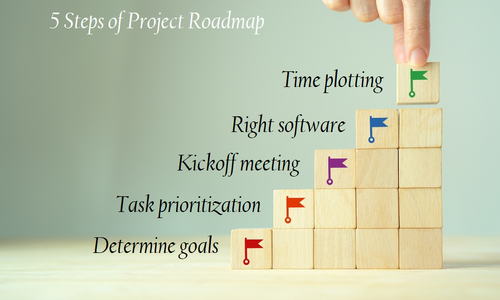‘Plan’ may be a literal synonym of ‘roadmap’ but the meaning of the two differ in the domain of project management. First, learning the difference between a project plan and a project roadmap is necessary.
Jump ahead to
Are Project Plan And Project Roadmap The Same Thing?
A project plan is an internal resource and is timeline-based. Project managers use this document to track a project’s aspects from the core and assign tasks. A plan contains information about the responsibilities and functions of individual members. The task details in the plan make project team members aware of the project’s progress. On the other hand, a project roadmap is the origin of a project plan.
A project roadmap is the overall strategic view of an entire project and its objectives. It is created for other teams of an organization to glance through and gain knowledge of the project’s execution. It is advantageous for executive and marketing departments or investors to update themselves about the project status. Besides, this overview is essential to streamline the project goals by breaking them into tasks for individual members.
Both the project plan and roadmap are practical tools to go about a project without any obstacles.

Constituents Of A Successful Project Roadmap
One must include the components listed below when preparing a project roadmap.
Project scope
Answers to questions like why this project should be performed or what its outcomes should be. A project roadmap must offer a glance at the project time frame along with its targets. It tracks if a project meets the expected goals and at what rate.
Milestones
These include the level indicators that determine how far a project is from completion. Hypothetical dates on which a project completes a specific stage are its achievements that mark progress.
Deliverables
Deliverables help stakeholders measure a project’s advancement simply by glancing through the roadmap. These are the recorded occurrences of a project’s tangible results within its lifecycle.
Resource management
Keeping the count of allocated resources, such as the labor and technology cost estimates, is necessary. This aspect of a project roadmap helps strike a balance between allotted resources and their users. It becomes easy to detect if a particular resource is still needed and in what quantity, to meet the project goals.
Key contacts
The contact information of the project team members must be present in the project roadmap. This facilitates accessible communication to ask for each other’s assistance even when that person isn’t available at the workplace.
Project timeline
It consists of the beginning and end dates of the different project tasks for an overall view. It allows stakeholders to analyze if a project is on a smooth sail or at risk. A project roadmap should offer a clear picture of the time estimates of the varying operations.
Possible risks
A project roadmap should consider the possible obstacles in a project lifecycle. This helps team members to avoid budget, workload, or schedule deviations. This results in the timely delivery of a commodity or service.
How To Prepare A Perfect Project Roadmap in Just 5 Steps?
Determine goals
The foremost step is to determine project goals. This keeps any confusion regarding individual tasks at bay. Each member of the project team becomes well aware of his or her responsibilities toward meeting project objectives.
Task prioritization
Not every function of a project is of the same priority to meet the desired results. Thus, a prior selection of tasks according to their significance in reaching the objectives is necessary. A project roadmap must contain a list of the activities in the order of their requirement at various stages.
Kickoff meeting
Kickoff meetings are quite impactful in introducing the project team members to stakeholders. It is essential to look for any gaps before the project’s initiation. A vital step to creating a project roadmap is to arrange such meetings. Project workers learn about stakeholder expectations in the discussions at these meetings.
Right software
Several templates are available online, but selecting the right tool is a must to prepare a successful project roadmap. Powerpoint and Excel are viable options, but a complicated project may demand the use of suitable software. This provides information storage for easy access of team members as and when they require any document.
Time plotting
Another vital feature of a project roadmap is that it is a visualization of the major tasks and stages. It exhibits the activities along with their corresponding due dates to track the project’s progress. Segregating each phase and marking it with an achievement streamlines the work and prevents workers from panicking.
The strength and functionality of a project roadmap lie in its simplicity. It shouldn’t be crowded with documents of unnecessary details like day-to-day task plans. Setting realistic goals and keeping the time frames flexible are essential so that no tasks remain pending. The goal of creating a project roadmap is to prevent cost overruns, project delays, and stakeholders’ dissatisfaction. Individuals undertaking the Project Management Professional Training course become well-versed in framing the proper project roadmap.



